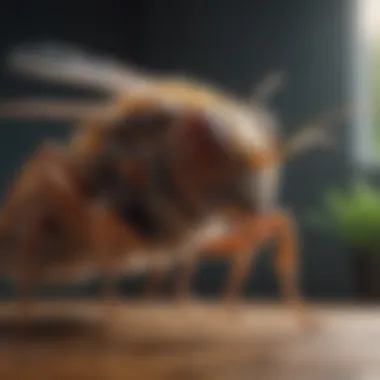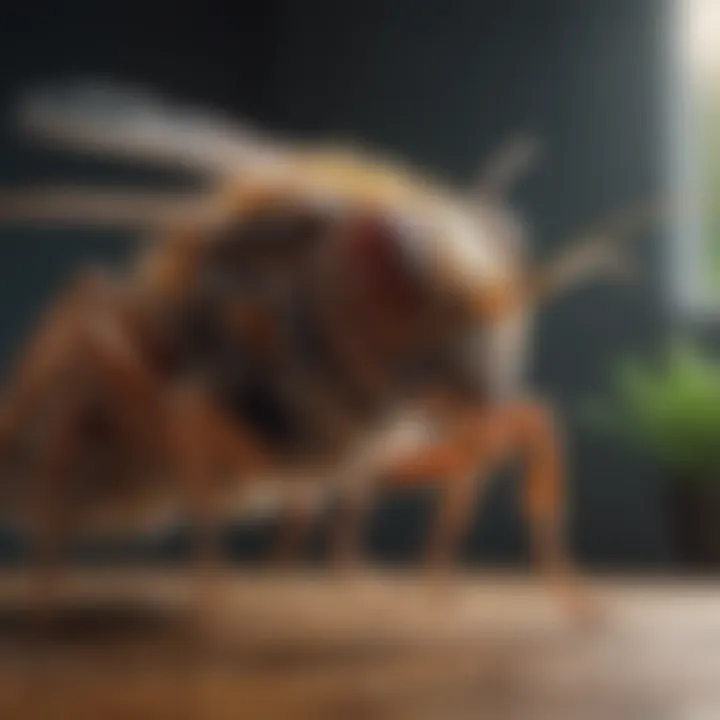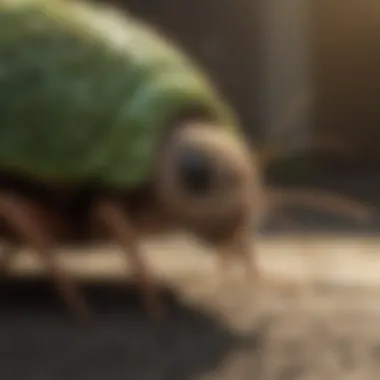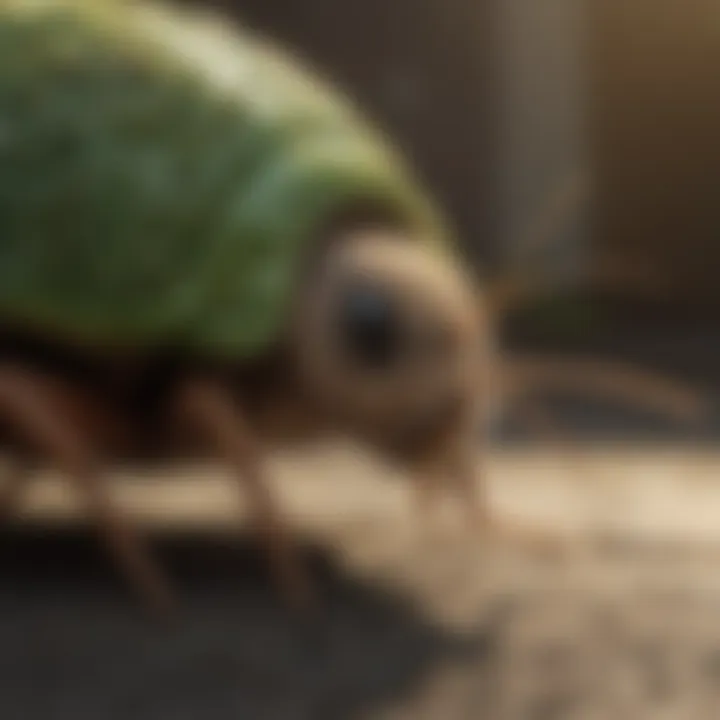Termax Pest Control: Sustainable Management Solutions


Preventive Pest Control Strategies
In the realm of pest management, a proactive stance is essential. Prevention acts as the first line of defense against potential infestations. Implementing effective preventive pest control strategies is crucial for maintaining a comfortable living environment.
House Exterior Protection
To start, the exterior of your house plays a significant role in keeping pests at bay. This begins with sealing cracks and crevices to deny insects easy access. Here are some tips for effective sealing:
- Inspect windows and doors for gaps.
- Use caulk or weatherstripping to seal the edges.
- Replace worn-out screens to prevent entry.
Clearing debris is another key aspect. Piles of leaves or wood near the foundation can attract pests. Ensure that the yard and exterior are well-maintained. Regularly clear away any clutter to minimize hiding spots.
Preventing pests from entering is not just about sealing; it's also about managing what’s around the home. Avoid planting shrubs or flowers too close to the walls. Create a buffer zone where pests find it difficult to thrive.
Yard Maintenance
Proper yard maintenance can deter a myriad of pests. Essential routines include:
- Regular mowing of grass to reduce hiding spots.
- Trimming overgrown shrubs or trees.
- Removing standing water, which is a magnet for mosquitoes.
Methods for keeping your yard pest-free may include using natural repellents like essential oils. People should also consider beneficial plants, which can attract insects that are predators to common pests.
Indoor Cleanliness
Maintaining cleanliness indoors is as vital as outdoor strategies. Following expert cleaning tips can help:
- Regularly sweep and vacuum areas to remove crumbs.
- Store food in airtight containers to keep pantry pests away.
- Wipe surfaces frequently to prevent residue build-up.
A pest-resistant indoor environment also means being cautious with items brought into the home. Check second-hand goods for signs of pests before bringing them inside.
Garbage Disposal
Efficient waste disposal is necessary for pest control. It is important to:
- Use tightly sealed garbage cans to deter scavengers.
- Regularly dispose of all household waste.
- Compost responsibly, ensuring to keep it covered.
Proper garbage disposal not only keeps the environment clean but can significantly reduce pest attraction.
Other Pest Prevention Strategies
Finally, consider innovative ways to safeguard your home. Engaging in community programs related to pest prevention can increase awareness. Furthermore, sharing knowledge with neighbors may lead to collaborative strategies that enhance overall community health.
"The best way to deal with pests is not to give them an invitation."
Through vigilance and active management, homeowners can significantly reduce their risk of pest invasions. It is all about setting up a thorough framework that addresses potential problems before they escalate.
Identifying Pest Risk Areas
Identifying areas at risk of pests goes hand in hand with preventive strategies.
Moisture Prone Areas Inspection
Moist environments are conducive to pests. Identifying damp conditions, especially bathrooms and basements, is key.
- Regularly check for leaks in plumbing systems.
- Insulate pipes to prevent condensation.
- Use dehumidifiers in humid areas.
Tips for preventing infestations focus on keeping these areas dry through good ventilation.
Crack and Crevice Inspection Guide
Access points like cracks and crevices must be inspected thoroughly. Sealing these openings is vital.
- Utilize silicone sealants for larger cracks.
- Fill smaller gaps with foam or caulk.
Greenery Inspection for Pest Risks
Greenery around the house can impact pest populations. Keeping plants healthy can help minimize risks.
- Regular inspections are necessary to monitor plant health.
- Remove any dead or decaying plants quickly.
Additional Pest Risk Areas
Be aware of miscellaneous areas that may pose risks such as:
- Garages where clutter can hide pests.
- Attics that may harbor rodents or insects.
Effective Pest Control Methods
When preventive measures do not suffice, effective pest control methods must be employed.
Natural Repellents for Pest Control
Natural solutions can be both safe and effective. Essential oils such as peppermint or lavender can repel various insects.
- Dilute oils with water and spray around entry points.
- Use herbs like basil or mint as companion plants.
Chemical Sprays for Pest Control
Professional chemical sprays play a role, though they require careful use.
- Always follow the manufacturer’s instructions.
- Ensure pets and children are away during application.
Pest Traps: Effective Pest Control Solutions
Setting up traps can be an immediate solution. Whether sticky traps for insects or baited traps for rodents, proper placement is key.
Biological Control Methods for Pest Prevention
Utilizing natural predators can provide an environmental-friendly approach. Introducing species like ladybugs can help manage aphid populations.
Other Pest Control Methods
Stay informed about innovative pest control methods available beyond traditional options. Keeping up to date with the latest advances in pest management can lead to better practices for your home.


Pest Species Identification
Awareness of pest types and their behaviors is crucial in implementing effective control measures.
Common Insects in Home Pest Control
Recognizing types of insects such as ants, cockroaches, and spiders can aid in addressing infestations effectively.
Identifying Rodents for Pest Prevention
Identifying the signs of rodent presence is crucial. Look for droppings or gnaw marks.
Bird Species Impacting Home Environments
Some bird species may create disturbances. Understanding issues related to pigeons or sparrows can assist in mitigation.
Dealing with Wildlife on Your Property
Wildlife encounters require appropriate handling. Learn how to manage encounters with raccoons or squirrels effectively.
Miscellaneous Pest Species Identification
Pay attention to lesser-known pests that can also invade homes. Understanding their habits can aid in early intervention.
DIY Pest Control Techniques
Do-it-yourself pest control can be empowering and effective.
Homemade Pest Control Solutions
Consider creating eco-friendly pest control remedies at home. Simple solutions with vinegar or baking soda can deter pests.
Using Essential Oils for Pest Control
Essential oils serve as natural deterrents. These can effectively repel pests while leaving a pleasant aroma in the house.
Effective Pest Traps and Barriers
Creating your own traps can be economical. Design various traps depending on the type of pest.
Top Reputable Pest Control Brands
Research and invest in products from trusted brands to aid in pest management. This ensures safety and effectiveness for homeowners.
Miscellaneous DIY Pest Control Techniques
Exploring unique solutions for specific pest issues can greatly enhance your pest management efforts.
By combining prevention with active management, homeowners can enjoy a pest-free environment. With persistence and knowledge, achieving a comfortable living space is feasible.
Prolusion to Termax Pest Control
Understanding the importance of sustainable pest management cannot be overstated. Termax Pest Control represents a significant step toward that understanding. It is not just about eliminating pests; it's about doing so in a manner that promotes environmental health and safety. Sustainable practices are essential in today's world, where the impact of pest control methods extends beyond immediate results, influencing ecosystems and human health.
Overview of Pest Control Industry
The pest control industry plays a vital role in maintaining public health and safety. With increasing urbanization, the need for effective pest control has grown more urgent. Termites, rodents, and various insects threaten properties, agriculture, and human health. Conventional pest control methods often rely on chemical solutions. However, the focus is shifting toward more sustainable practices, which prioritize long-term solutions over temporary fixes. Industry trends reveal that consumers are becoming more aware of the environmental repercussions of pest management techniques. Consequently, there is a growing demand for companies that offer environmentally friendly options. Termax stands at the forefront of this movement.
Termax’s Position in the Market
Termax Pest Control occupies a unique position in the pest control market. They have made significant investments in research and development, allowing them to provide innovative solutions tailored to sustainable practices. Their strategies emphasize Integrated Pest Management (IPM), which combines biological, cultural, and mechanical control methods. As a result, Termax is not just a service provider; they are a leader in promoting eco-friendly pest management.
Their reputation hinges on a commitment to education and transparency. By informing clients about the methods used and the rationale behind them, Termax builds trust and reinforces its dedication to sustainability. Households looking to combat infestations can feel confident when choosing Termax, knowing their approach aligns with modern environmental standards.
Understanding Pest Control
Understanding pest control is crucial for housewivecs and home owners alike. This knowledge helps in identifying problems, selecting appropriate solutions, and maintaining a pest-free environment. By grasping the nuances of pest behavior and the various types of pests, individuals can make informed decisions about the pest management strategies they implement. This understanding ultimately leads to more effective control methods and sustainable practices in residential spaces.
Types of Pests
Insects
Insects represent a highly diversified group of pests that can cause significant damage within homes and gardens. Their key characteristic is that they reproduce quickly. This ability allows for rapid infestation if not managed promptly. Common household insects include ants, roaches, and termites. These insects are a popular focus in pest management articles because they often require immediate attention.
One unique feature of insects is their varied resistance to certain chemical treatments. As a result, effective insect management usually combines several strategies to reduce infestations. This can include the use of baits, traps, and sometimes chemical solutions. However, relying on chemical agents poses possible health risks, emphasizing the need for integrated approaches to manage them effectively.
Rodents
Rodents, such as rats and mice, are another significant category of pests. Their key characteristic lies in their ability to gnaw through various materials, leading to structural damage and potential safety hazards. Their presence is also a public health risk due to the diseases they may carry.
A unique quality of rodents is their highly adaptive behavior. This adaptability enables them to thrive in different environments, making them a persistent challenge for home owners. Effective management often requires the use of both exclusion techniques, to keep them out of buildings, and trapping solutions. The use of poison is a controversial method and should be avoided where pets and children are present.
Wildlife
Wildlife includes larger pests such as raccoons, squirrels, and deer, which can invade residential areas. Their key characteristic is their instinct to forage for food, which often leads them to homes. This behavior can result in damage to gardens, landscapes, and even homes.
Wildlife control is beneficial because it helps to protect both property and the local ecosystem from harm. A unique feature of managing wildlife is the ethical considerations involved. Many municipalities have specific regulations regarding the humane treatment of wildlife. Methods for managing these pests often include physical barriers and habitat modification to deter them from entering human space.
Pest Behavior and Biology
Understanding pest behavior and biology is an essential part of pest management. Knowing how pests behave can help in predicting their movements and nesting habits, allowing for more precise management strategies. Different species exhibit distinct reproductive patterns, feeding habits, and preferred living conditions.
For instance, insects like ants communicate through pheromones, enabling them to work collectively and build complex colony structures. By understanding these social behaviors, house owners can target their control methods more effectively.
Additionally, considering the biology of pests allows for the formulation of preventive strategies. For example, knowing that rodents are nocturnal helps in deciding the best times to deploy traps.
Overall, both the identification of pests and an understanding of their biology are foundational to achieving successful pest control.
"Understanding both the types of pests and their behavior equips home owners with the tools needed for effective pest management and prevention."
The Science Behind Pest Control
In an era increasingly defined by environmental sustainability, understanding the science behind pest control is essential. Termax Pest Control taps into scientific principles to develop effective strategies for managing pest populations. This section draws attention to both chemical and biological methods as foundational components in the pest control framework. By leveraging scientific knowledge, Termax can address pest issues efficiently while also considering ecological impacts.
Chemical Controls


Types of Chemical Agents
Chemical agents constitute a primary line of defense in pest management. These substances are designed to target specific pests without causing undue harm to the environment. Common types of chemical agents include insecticides, rodenticides, and fungicides. Each of these agents operates through different mechanisms—some disrupt biological processes in pests, while others might suffocate or poison them. The key characteristic of these agents is their specificity; they can be formulated to minimize collateral damage to non-target species. This makes them a popular choice in the realm of pest control.
However, notable advantages come with these chemical agents, such as rapid effectiveness and ease of application. On the downside, there exists a significant concern regarding residue and its potential impact on surrounding ecosystems. Furthermore, repeated use can lead to unintended consequences in pest populations.
Resistance Issues
Resistance issues present a major challenge in the ongoing battle against pests. Over time, certain pests can develop a resilience to specific chemical agents, rendering those tools less effective. This resistance is typically driven by genetic variation in populations, where those not affected by the chemical survive and reproduce. Understanding resistance is crucial for Termax as it informs their choices of chemicals and application methods.
The key feature of resistance is its potential to undermine pest control strategies, creating a scenario where traditional methods fall short. This is highly detrimental, as it requires ongoing adaptation of treatment plans. The advantages of addressing resistance include the ability to refine applications for maximum efficacy while minimizing environmental impact, leading to a more sustainable approach in pest control.
Biological Controls
Natural Predators
The use of natural predators represents a non-invasive strategy in pest control. Utilizing organisms that prey on pests not only helps manage pest populations but also supports the broader ecological balance. Examples of natural predators include ladybugs for aphids, or parasitoid wasps for caterpillars. Their role is vital in integrated pest management systems. The key characteristic of these natural predators is their self-sustainability; once established in an environment, they can provide ongoing pest control without continuous input from humans.
Advantages of using natural predators include reducing reliance on chemical controls, hence minimizing harmful residues in the environment. Nevertheless, there are challenges in managing these populations and ensuring they thrive in the intended environments.
Microbial Solutions
Microbial solutions offer another biological approach to pest control. These solutions utilize bacteria, fungi, or viruses specially tailored to target specific pest species. Their mode of action often involves infection or disruption of growth cycles in pests. One significant characteristic of microbial solutions is their ability to break down over time, reducing long-term environmental impacts.
By integrating microbial approaches, Termax Pest Control can complement more traditional methods, creating a holistic pest management strategy. Despite their potential, microbial solutions do have limitations, including sensitivity to environmental conditions, which can influence their effectiveness.
"A balanced approach that includes both chemical and biological controls can lead to more sustainable pest management outcomes."
In summary, the integration of scientific principles into pest control at Termax represents an evolving strategy aimed at enhancing effectiveness while maintaining environmental integrity. Both chemical and biological methods play distinct yet important roles in this mission.
Technological Advancements in Pest Control
Technological advancements have changed the landscape of pest control in significant ways. These innovations not only improve the effectiveness of pest management strategies but also address concerns related to sustainability. By incorporating advanced tools, pest control experts can now better target infestations while minimizing the impact on the environment. The adoption of new technologies allows for efficient resource use and enhances the precision of pest control measures.
Use of Drones
Mapping Infestations
Drones have emerged as an important tool in the mapping of infestations. This specific aspect of drone technology allows pest control professionals to survey large areas quickly and accurately. With the ability to capture high-resolution images from various angles, drones provide detailed insights into the scope of pest problems. Additionally, mapping infestations helps in the planning of targeted intervention strategies. This characteristic makes drone mapping a beneficial choice for pest control since it saves time and resources.
The unique feature of drones is their capability to access hard-to-reach areas, such as rooftops and remote fields. This advantage allows for a more comprehensive understanding of infestation dynamics. However, there are considerations regarding the cost of drone technology and the need for skilled operators, which can pose challenges for some pest management companies.
Precision Application
Precision application is a crucial aspect of contemporary pest control practices. This method focuses on delivering pest control substances precisely where needed, reducing waste and exposure to non-target organisms. The use of drones for precision application allows for the targeted dispersion of pesticides or other control methods. This feature is advantageous as it increases the effectiveness while minimizing environmental risks.
While precision application from drones offers significant benefits, it also comes with limitations. Drones may require specific conditions to operate effectively, and factors like wind and weather can affect performance. Ensuring the right timing for applications based on weather patterns and pest behavior becomes essential.
Smart Traps and Sensors
Real-Time Monitoring
Real-time monitoring technologies have transformed how pest control professionals gather data. This characteristic provides immediate insights into pest activity levels and patterns. By employing smart traps equipped with sensors, pest control services can collect data on infestations without constant manual checks. This method enhances the speed at which professionals can respond to new pest issues, making it a valuable choice in modern pest management.
The unique feature of real-time monitoring is its ability to send alerts and update data remotely. Pest control experts can access information instantaneously, helping to prioritize actions and allocate resources effectively. However, the dependence on technology means that errors in data transmission or device malfunctions can lead to overlooked issues if not managed correctly.
Data Collection
Data collection is a critical component of effective pest management practices. Smart traps and sensors facilitate extensive data collection, allowing pest management professionals to analyze trends over time. This specific aspect is vital for understanding when and where pests are most active, leading to more informed decision-making.
The key characteristic of enhanced data collection methods is the ability to accumulate vast amounts of information efficiently. This streamlining of data makes it easier for pest control companies to adjust their strategies based on empirical evidence. While this represents a significant opportunity, the management of large datasets necessitates appropriate software solutions, which could be a barrier for some smaller firms.
Technological advancements in pest control provide new opportunities for enhanced efficiency and sustainability, ensuring pest management practices meet both professional standards and environmental needs.
Sustainable Pest Control Practices
Sustainable pest control practices are crucial in today’s world. As environmental concerns increase, the need for effective pest management that minimizes ecological disruption becomes more pressing. Termax Pest Control has taken a proactive stance by implementing methods that balance pest eradication with environmental health. These practices not only protect structures from damages caused by pests but also ensure a safer environment for humans and non-target species. By integrating sustainability into pest management, Termax positions itself as a forward-thinking leader in the industry.
Integrated Pest Management (IPM)
Definition and Principles
Integrated Pest Management integrates multiple strategies to manage pests effectively and sustainably. It emphasizes the importance of understanding pest life cycles and behaviors, allowing for a more strategic approach to control. This method is beneficial because it reduces reliance on chemical solutions, focusing instead on prevention and monitoring. A unique feature of IPM is its adaptability; strategies can be adjusted based on the level of pest infestation and the specific context of the environment.
This adaptability is an advantage in urban residential spaces where methods must fit unique surroundings.
Implementation Strategies
Effective implementation strategies are key to the success of IPM. Termax employs thorough tracking and data collection systems to accurately assess pest populations. These strategies highlight collaboration with clients, ensuring they are informed and engaged. Special attention is given to cultural practices and habitat modification, which can significantly deter pest establishment. This focus on client involvement allows for a favorable pest management environment, while also promoting awareness. However, ongoing communication is necessary, as success depends on consistent monitoring and assessment of pest activity.
Organic Pest Control Options
Benefits of Organic Methods
Organic pest control methods offer several advantages, particularly in maintaining human and environmental health. These methods often utilize natural substances, which minimizes chemical exposure to occupants and pets. Additionally, organic treatments tend to have a lower environmental impact. A key characteristic of organic methods is their emphasis on prevention and habitat enhancement, which can contribute to long-term pest management solutions. This preventive approach aligns well with Termax’s commitment to sustainability, making it a popular choice among environmentally conscious homeowners.
Limitations
Despite their many advantages, organic pest control options come with limitations. One significant challenge is the often slower action of organic treatments compared to traditional chemicals. For instances where immediate eradication is necessary, this can be a drawback. Furthermore, the effectiveness can vary widely depending on specific pest types and environmental conditions. It is crucial for clients to understand these limitations to set realistic expectations regarding the outcomes of organic methods. Consequently, education on timing and awareness of specific pest challenges is essential.
"Sustainable pest control practices not only protect our environments but also enhance the quality of life for residents by promoting safer living conditions."
Challenges in Pest Control
In modern pest management, it is essential to navigate various challenges effectively. These challenges can influence both the strategic approach and operational efficiency of pest control measures. Addressing these struggles helps to create clear pathways toward enhanced pest management practices that align with sustainability goals.
Public Perception of Pest Control
The public perception of pest control plays an important role in the industry. Many homeowners view pest control as necessary but may have reservations regarding safety and environmental impact. Concerns about chemical use and the potential harm to pets and children often dominate conversations. Education is necessary to shift perceptions. Highlighting the efficacy and safety of modern pest control methods can alleviate fears. Companies like Termax strive to showcase their sustainable practices and eco-friendly products. This not only helps build trust but also enhances customer satisfaction.
Regulatory Issues
Regulatory issues present unique challenges in pest control, influencing how businesses operate and guarantee safety.
Compliance Challenges


Compliance challenges refer to the difficulties pest control companies face in adhering to local and national regulations. These regulations are intended to ensure safety and environmental responsibility. The key characteristic of these challenges lies in the diverse landscape of bills and standards across regions. This makes it hard for companies to remain compliant while providing services.
The need for companies to consistently monitor and adapt their methods to meet regulatory demands can lead to increased operating costs. However, it is beneficial as it pushes companies to innovate and seek methods that align with both effectiveness and safety. A unique feature of these compliance challenges is the potential for varying interpretations of regulations, leading to confusion among service providers and consumers alike. This complexity often forces pest control firms to invest in training and legal consultation, which can be seen as an advantage or disadvantage, depending on the perspective.
Impact on Methods Used
The impact on methods used in pest control is significant. Regulatory frameworks can dictate the types of products and techniques employed in pest management. This often encourages the adoption of sustainable practices. The key characteristic here is the necessity for companies to provide solutions that are not only effective but also aligned with legal standards.
As pest control moves towards more sustainable methods, companies like Termax find that this not only helps in compliance but also satisfies growing consumer demand for eco-friendly solutions. A unique feature of this influence is the resultant shift toward using fewer harmful chemicals, fostering a greater dependency on innovation within the industry. This transition can present challenges due to potential limitations in effectiveness, but the long-term environmental benefits often outweigh these drawbacks.
"Navigating regulatory issues and public perception are crucial for the future of pest control. Companies must adapt and evolve to meet these challenges to remain relevant."
Understanding these layers of challenges is essential for stakeholders in the pest control sector. Awareness leads to better decision-making, which can ultimately drive improvements in public perception, regulatory compliance, and the effectiveness of pest management solutions.
Case Studies in Termax Pest Control
Case studies serve as a vital component in understanding the effectiveness and practical applications of Termax Pest Control methods. They provide real-world examples showcasing how pest management strategies can be effectively tailored to address various situations. By examining these cases, potential clients can gain insights into the diverse range of services offered, helping to demystify the pest control process.
Additionally, case studies highlight the successes achieved through personalized approaches. They present evidence-based results that can reinforce consumer trust in Termax as a reliable solution for pest management. These narratives often cover factors such as the type of pest, the methods employed, and the outcomes achieved, forming a comprehensive picture of the services provided.
Real life examples are essential for understanding not just how the solutions work, but also how they adapt to unique environments and challenges. This allows potential customers to envision how similar strategies can be applied within their contexts.
Residential Solutions
In residential settings, Termax Pest Control focuses on common nuisances that often disrupt the living environment. For instance, one notable case involved a suburban family that faced a significant infestation of ants, which were entering through poorly sealed doors. Termax's team conducted a thorough inspection, identifying not only the entry points but also the nesting areas.
The strategy employed included:
- Sealing Entry Points: Addressing the structural vulnerabilities.
- Baiting Systems: Utilizing targeted bait that was safe for pets and children.
- Follow-Up Treatments: Monitoring and adjusting methods based on observed results.
The outcome was successful, as the family reported a dramatic reduction in ant activity within a week. This case exemplifies how Termax can effectively address residential pest issues while ensuring the safety of the inhabitants.
Commercial Solutions
Commercial spaces pose unique challenges due to higher traffic and more complex structures. In one example, a restaurant faced a recurring issue with rodents, risking health violations and customer dissatisfaction. Termax implemented a comprehensive plan that included:
- Inspection of Facilities: Identifying potential entry points and nesting sites.
- Integrated Pest Management: Applying a mix of trapping and exclusion methods for long-term control.
- Staff Training: Educating employees about maintaining a pest-free environment.
After the implementation, the restaurant noted not only a significant decline in rodent sightings but also improved overall cleanliness and customer satisfaction ratings.
These case studies illustrate the effectiveness of Termax Pest Control in diverse environments while emphasizing the need for tailored strategies to suit specific needs. The careful analysis of each situation ensures that solutions are targeted and sustainable, paving the way towards a pest-free future.
Termax's Commitment to Research and Development
Research and development is a crucial element in ensuring sustained effectiveness in pest management. Termax Pest Control understands this need. The company’s dedication to research is not just a strategy for growth; it is a commitment to enhancing the efficacy and safety of pest control solutions. By prioritizing R&D, Termax aims to stay ahead of trends, cater to changing consumer needs, and address environmental concerns.
Investments in Innovation
Investing in innovation is foundational to Termax's strategy. The company allocates significant resources to develop new methods and technologies. This focus on innovation reveals several benefits:
- Enhanced Product Efficacy: Continuous innovation leads to more effective pest control solutions. Termax's developments often result in quicker and more reliable pest elimination.
- Safety Improvements: New formulations and techniques prioritize the safety of both consumers and the environment. This helps in minimizing adverse effects typically associated with traditional pest control methods.
- Cost Efficiency: Innovative methods often result in cost savings for both the company and customers. More efficient treatments can lead to lower overall expenditures in pest management.
Moreover, Termax's investments in product development include conscious adjustments to align with sustainable practices. This approach ensures that advancements do not compromise environmental integrity.
Partnerships with Research Institutions
Building partnerships with research institutions is another cornerstone of Termax’s R&D strategy. Collaborations with universities and scientific organizations enable Termax to:
- Access Expertise: Partnering with academic experts provides valuable insights into pest behavior and biology, enabling innovative solutions tailored to specific pest challenges.
- Leverage Cutting-Edge Research: Staying abreast of the latest scientific advancements allows Termax to incorporate new methodologies into their pest control strategies.
- Conduct Field Studies: Research partnerships facilitate field studies. These informed trials yield data essential for optimizing pest control techniques and recognizing trends.
Through these partnerships, Termax fosters an environment of continuous improvement. This commitment ensures that their pest control strategies are not only effective but also responsible and aligned with current scientific understanding. Termax Pest Control remains at the forefront, adapting to new findings and trends that influence the industry’s future.
"Research and development is not just an option; it is a necessity for genuine advancement in pest control solutions."
By committing to rigorous research and development, Termax Pest Control enhances its position as a leader in sustainable pest management, ultimately benefiting homeowners and promoting environmental health.
Future Trends in Pest Control
The pest control industry is continually evolving. As environmental concerns rise, so does the need for more sustainable approaches. This section explores future trends that will shape pest management in the years to come. Adopting these trends can lead to more effective pest solutions. Homeowners should consider how these advancements can benefit their pest management practices.
Emerging Technologies
Innovations in technology have significant implications for pest control. Drones, for instance, are becoming essential tools for surveying large areas and identifying pest infestations. These aerial devices can efficiently map affected areas and save valuable time.
Smart traps are another effective technology. They utilize sensors to detect pests and can provide real-time data to operators. This capability allows for faster responses and more precise treatments. The integration of these technologies not only enhances efficiency but can also reduce the environmental impact of pest control methods.
- Drones: Great for assessing extensive properties and targeting pest populations accurately.
- Smart Traps: Offer quick alert systems that streamline pest management processes.
Furthermore, the advent of artificial intelligence in pest control can lead to more effective strategies. AI can analyze patterns in pest behavior and predict future infestations, allowing for timely interventions. Homeowners can benefit by receiving proactive solutions tailored to their specific situations.
"The integration of technology in pest control represents a shift towards more effective, efficient, and environmentally responsible methods."
Shifts in Consumer Demand
Consumer expectations are changing. There is a growing preference for environmentally friendly and sustainable pest management solutions. Many homeowners are now more informed about the impacts of chemical pesticides. They seek out services that prioritize safe, organic alternatives.
This shift in demand influences pest control companies to adjust their strategies. Businesses like Termax Pest Control are evolving to meet these needs. They focus on integrated pest management techniques. These techniques reduce reliance on harmful chemicals and emphasize natural solutions.
To appeal to this eco-conscious consumer base, companies can:
- Educate clients about alternative pest control methods.
- Promote the use of organic solutions, emphasizing their effectiveness.
- Highlight the benefits of preventive measures to minimize the need for treatments.
As consumers prioritize sustainability, pest control firms must innovate to keep pace. By incorporating environmentally sound practices, they can not only attract clients but also contribute to a healthier ecosystem.
These future trends in pest control are crucial for homeowners and the industry alike. By understanding and adapting to these changes, consumers can play an active role in sustainable pest management.
Closure
In this converstation, we have discussed why Termax Pest Control is essential for sustainable pest management. The article delves into various aspects that make Termax a leader in the pest control industry, especially in adopting sustainable practices. Understanding these aspects can aid not only professionals but also homeowners and their families in making informed decisions.
Summary of Key Points
Several key points arise from our thorough examination:
- Comprehensive Approach: Termax offers a multi-faceted strategy to pest management, incorporating technology and research.
- Sustainability Focus: The emphasis on sustainable methods reflects a commitment to protecting the environment.
- Innovative Solutions: Utilization of modern technology enhances pest control effectiveness, making it safer for household use.
- Education and Research: Ongoing research and development enhance Termax’s methods and keeps them at the forefront of industry practices.
"Sustainable pest control is not just a trend; it is an essential practice moving forward."
Final Thoughts on Termax Pest Control
Sustainable pest management is not merely an option; it is a necessity. Choosing Termax means choosing responsibility, efficacy, and a healthier environment.



